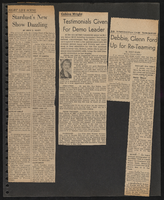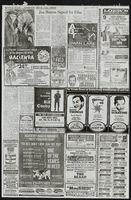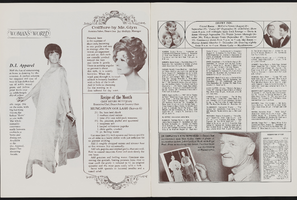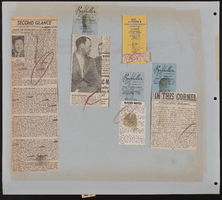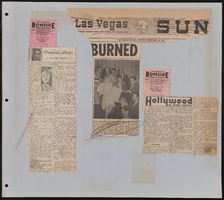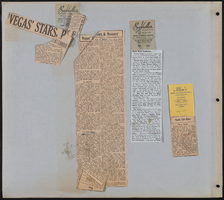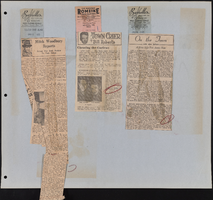Search the Special Collections and Archives Portal
Search Results

James Healey, Heidi Swank, Ruben Kihuen, Kelvin Atkinson, Tony Clark, and Mother Loosey Lust Bea Lady (Tracy Skinner) and others attend the Club Metro bar grand opening, Las Vegas, Nevada: digital image
Date
2013-07-20
Archival Collection
Description
From the Dennis McBride Photograph Collection (PH-00263) -- LGBTQ+ events and organizations in Las Vegas, Nevada -- Digital images file. Notes from the donor, Dennis McBride: Kelvin Atkinson came out on the floor of the Nevada Senate on April 22, 2013 while arguing against the state's proscription of same-sex marriage. On October 9, 2014 Atkinson and his partner, Sherwood Howard, became the first same-sex couple to marry in Nevada. Atkinson resigned his office on March 5, 2019 over accusations he misappropriated campaign funds for his personal use. He was convicted of fraud and sentenced to prison on July 18, 2019. ... Ruben Kihuen was later elected to the U. S. House of Representatives from Nevada's District 4. Accused of sexual misconduct he did not seek re-election in 2018. Individuals identified by the donor, Dennis McBride: unidentified Latino man; James Healey [Nevada State Assemblyman, District 35, Democrat (gay)]; Heidi Swank [Nevada State Assemblywoman, District 16, Democrat]; Ruben Kihuen [Nevada State Assemblyman, District 10, Democrat]; Kelvin Atkinson [Nevada State Senator, District 4, African American, Democrat (gay)]; David Parks [Nevada State Senator, District 7, Democrat (gay)]; unidentified Club Metro owner; unidentified man; Mother Loosey Lust Bea Lady [aka Tracy Skinner (Sin Sity Sisters of Perpetual Indulgence)]; Tony Clark; unidentified Sin Sity Sister
Image

James Healey, Heidi Swank, Ruben Kihuen, Kelvin Atkinson, Tony Clark, and Mother Loosey Lust Bea Lady (Tracy Skinner) and others attend the Club Metro bar grand opening, Las Vegas, Nevada: digital image
Date
2013-07-20
Archival Collection
Description
From the Dennis McBride Photograph Collection (PH-00263) -- LGBTQ+ events and organizations in Las Vegas, Nevada -- Digital images file. Notes from the donor, Dennis McBride: Kelvin Atkinson came out on the floor of the Nevada Senate on April 22, 2013 while arguing against the state's proscription of same-sex marriage. On October 9, 2014 Atkinson and his partner, Sherwood Howard, became the first same-sex couple to marry in Nevada. Atkinson resigned his office on March 5, 2019 over accusations he misappropriated campaign funds for his personal use. He was convicted of fraud and sentenced to prison on July 18, 2019. ... Ruben Kihuen was later elected to the U. S. House of Representatives from Nevada's District 4. Accused of sexual misconduct he did not seek re-election in 2018. Individuals identified by the donor, Dennis McBride: unidentified Latino man; James Healey [Nevada State Assemblyman, District 35, Democrat (gay)]; Heidi Swank [Nevada State Assemblywoman, District 16, Democrat]; Ruben Kihuen [Nevada State Assemblyman, District 10, Democrat]; Kelvin Atkinson [Nevada State Senator, District 4, African American, Democrat (gay)]; David Parks [Nevada State Senator, District 7, Democrat (gay)]; unidentified Club Metro owner; unidentified man; Mother Loosey Lust Bea Lady [aka Tracy Skinner (Sin Sity Sisters of Perpetual Indulgence)]; Tony Clark; unidentified Sin Sity Sister
Image
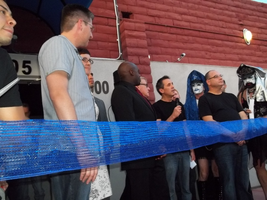
James Healey, Heidi Swank, Ruben Kihuen, Kelvin Atkinson, Tony Clark, and Mother Loosey Lust Bea Lady (Tracy Skinner) and others attend the Club Metro bar grand opening, Las Vegas, Nevada: digital image
Date
2013-07-20
Archival Collection
Description
From the Dennis McBride Photograph Collection (PH-00263) -- LGBTQ+ events and organizations in Las Vegas, Nevada -- Digital images file. Notes from the donor, Dennis McBride: Kelvin Atkinson came out on the floor of the Nevada Senate on April 22, 2013 while arguing against the state's proscription of same-sex marriage. On October 9, 2014 Atkinson and his partner, Sherwood Howard, became the first same-sex couple to marry in Nevada. Atkinson resigned his office on March 5, 2019 over accusations he misappropriated campaign funds for his personal use. He was convicted of fraud and sentenced to prison on July 18, 2019. ... Ruben Kihuen was later elected to the U. S. House of Representatives from Nevada's District 4. Accused of sexual misconduct he did not seek re-election in 2018. Individuals identified by the donor, Dennis McBride: unidentified Latino man; James Healey [Nevada State Assemblyman, District 35, Democrat (gay)]; Heidi Swank [Nevada State Assemblywoman, District 16, Democrat]; Ruben Kihuen [Nevada State Assemblyman, District 10, Democrat]; Kelvin Atkinson [Nevada State Senator, District 4, African American, Democrat (gay)]; David Parks [Nevada State Senator, District 7, Democrat (gay)]; unidentified Club Metro owner; unidentified man; Mother Loosey Lust Bea Lady [aka Tracy Skinner (Sin Sity Sisters of Perpetual Indulgence)]; Tony Clark; unidentified Sin Sity Sister
Image
Pagination
Refine my results
Content Type
Creator or Contributor
Subject
Archival Collection
Digital Project
Resource Type
Year
Material Type
Place
Language
Records Classification

